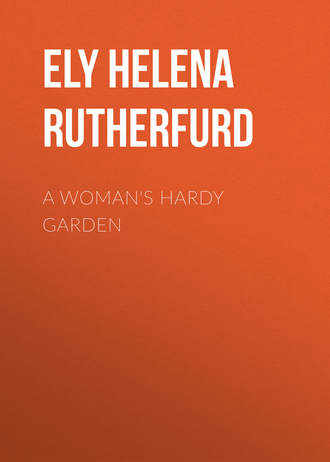 полная версия
полная версияA Woman's Hardy Garden
All ferns should be transplanted late in the autumn, or very early in the spring before the fronds are started, as they are very easily broken. This is particularly the case with ferns from wet places. When planted on the east or north side of a house, the tall ones at the back, and Maidenhair and other low varieties in front, they make a beautiful bank of cool green. They must be kept moist, however, to be successful, and in dry weather require a daily soaking.

Vase of Delphinium (Perennial Larkspur)
June twenty-first
The Cardinal Flower, whose natural haunt is along the banks of streams, and whose spikes are of the most beautiful red, can also be safely transplanted, and will bloom in deep, rich soil equally well in shade or sun and will be very effective among the Ferns. About the end of November, after cutting the dead stalks, cover each plant with a piece of sod, laid grass-side down. Remove this the first of April, and the little sprouts will soon appear above the ground. Cardinal Flowers bloom for nearly a month – during the last two weeks of August and first two weeks of September.
HOW TO PLANT A SMALL PLOT
CHAPTER IV
HOW TO PLANT A SMALL PLOTI am frequently surprised to hear people say, “Oh, a flower garden is very nice, but such a trouble!” I have heard this expression several times from friends who employ a number of men and have large places with extensive lawns, shrubberies and vegetable gardens, but without flowers, except, perhaps, a few annuals growing among the vegetables.
Yet no one is indifferent to the beauty of garden, or unobservant of the improvement which even a few flowers can make around the humblest cottage. Think of the pretty thatched cottages one sees everywhere in England and France, covered to the eaves with Roses and Clematis, and surrounded by flowers growing wherever they can find root in the tiny gardens. Yet all this is the result of only a half hour’s daily care after the long day’s work is done.
One should begin with a few plants – perhaps a dozen only – and the “trouble” will soon become a delight, unless one is devoid of all love for flowers.

Vase of Peonies
June sixth
Whenever I hear remarks on the “trouble” of a flower garden, I think of those peasant homes, and also of a little plot grown and cared for by a certain tenant farmer’s wife I know. She has six children, and must cook and bake and clean for four men in addition; yet, some time every day, she finds a few minutes to tend her flowers. She has a border along the fence four by fifty feet, filled with perennials; a border across the front of her house with Phlox and Funkias, and a couple of beds with Asters, Poppies, Balsams, Portulaca and Pinks. The perennials were given her, a few at a time. She separated the roots, saved the seeds to raise others, and has been able in this way to increase her borders. The seeds of the few annuals she buys do not cost more than a dollar a year. Thus, for a trifling expenditure and a short time every day, this woman makes her humble surroundings beautiful, while her soul finds an object upon which to expend its love of beauty, and her thoughts have a respite from the daily cares of life.
Many people have the mistaken idea that a flower garden, however small, is an expensive luxury, and are so convinced of this, that they never venture any attempt at gardening, and pass their lives knowing nothing of its pleasures.
Let us suppose some one is starting a suburban home in a simple way, and see how flowers can be had for many months at small cost. If one has a place in a town or village, the plot of ground not over fifty by two hundred feet, still the possibilities are great, and the owner can easily gather flowers for herself and her friends from April until mid-November. A house or cottage on such a piece of ground generally stands back from twenty to fifty feet, with a gravel or flagged walk running to the street. If the owner be a beginner in gardening and expects to do most of the work herself, let her commence with a few plants in a small space. As the plants thrive and become beautiful, the care of them will give an added pleasure to life, and, little by little, the beds and borders can be increased.
In beginning to plant a small plot, the most natural place first is a border, say two feet wide, on either side of the walk leading from the house to the street. Have these borders dug out and made properly. Then, if the owner wishes to see them continually abloom, bulbs must be planted, to give the early spring flowers. Tulips can be had for eighty cents a hundred, Narcissus Poeticus for sixty-five cents a hundred, and Yellow Daffodils for one dollar and twenty-five cents a hundred. Hyacinths are more expensive, and cost from four dollars a hundred up. If a hundred each of the Tulips, Narcissi, Hyacinths and Daffodils were planted they would make the borders lovely from early in April until late in May. The Daffodils will bloom first, then the Hyacinths, followed by the Narcissi, and the Tulips last, if care is taken to buy a late variety.
There should certainly be three or four Peonies in the borders, – pink, white, and dark red; good roots of these can be had for about thirty-five cents each. Once planted, they should not be disturbed for years; and, although the first season they may not yield more than two or three blossoms, in each succeeding year the flowers will increase in number. A friend told me, not long ago, that she had counted sixty blossoms upon each of several of her plants.
There should also be at least a dozen Columbines (Aquilegias) to bloom the end of May and the first of June. The roots of these can be bought for a dollar and a half a dozen, or they can be raised from seed; in the latter case, however, they would not bloom until the second year, being perennials.
No border can be complete without Delphiniums (Larkspur). Good-sized roots of the Delphinium formosum, lovely dark blue, are a dollar and twenty-five cents a dozen. Formosum Cœlistina, the light blue variety, is two dollars and a half a dozen. Then, of course, there must be other perennials, – Phlox, at least a dozen plants in the different colours, which will cost a dollar and a half.
A few Lilies will add greatly to the beauty of the borders. Tiger Lilies, which are only sixty cents a dozen; Auratums, which can be had from eighty-five cents a dozen up, according to the size of the bulbs; Speciosum rubrum from eighty-five cents a dozen up, and Candidums, or Madonna Lilies, a dollar and a half a dozen. German Iris, a dollar a dozen, and Japanese Iris, at a dollar and a quarter a dozen, should also have a place.

Lilium speciosum rubrum
September fifteenth
Excellent Gladioli can be bought for a dollar and fifty cents a hundred, and these will be most satisfactory if planted in the border about May fifteenth in groups of six to ten.
A dozen Chrysanthemums of the hardiest varieties to be obtained, and costing a dollar and a half a dozen, will, with the other plants mentioned, about fill two borders two feet wide by thirty long. It would also be well to sow the seeds of some Calendulas, Nasturtiums and Asters wherever there may be a vacant place. Or better, perhaps, sow the seeds in boxes in mid-April, and transplant to the border the early part of June. The first cost will be the only expense for these borders, except in the case of the Auratum Lilies, which will die out in about three years, and of the few flower seeds. The only care needed is to keep the borders free from weeds, to stir the soil every week, and to water after sunset in dry weather.
It will be seen, from the following list, that such borders can easily be made and planted at a cost of less than thirty dollars. This can be reduced by omitting the Hyacinths. Directions for planting are given elsewhere.

After a year or two, the owner of the cottage may want to increase the flower garden, and the next place to plant is close about the house. It is to be taken for granted that the house and piazzas have the proper gutters. This is necessary, of course, for the preservation of the house, and without gutters the drip from the eaves would be such that nothing could grow directly against the house.
The bed might be three feet wide and run across the front of the house on either side of the steps. The owner would probably wish to plant vines over the porch or piazza, in case it has not already been done. The best for this purpose are mentioned elsewhere.
Should the house front the south, east or west, nearly everything can be grown; but should it face the north, nothing but Ferns and Rhododendrons would be successful on the front. Dahlias of the Cactus variety, in different colours, could be planted at the back of the bed on one side of the steps. Get good-sized roots, plant them two feet apart. They will grow against the house like a tall hedge. If planted the third week in April quite deep, say eight inches, they will begin to bloom about the sixth of July, and continue to be covered with flowers until killed by frost. In front of the Dahlias, plant white Phlox. In front of the Phlox sow a row of Centaurea or Cornflowers, the Emperor William variety. These should be sown early in April, will begin to bloom by June tenth, and, if they are not allowed to go to seed, will blossom all summer. Sow in front of the Cornflowers, at the same time, a row of white Candytuft, of the Empress variety. This also will bloom continuously if the flowers are cut as soon as they wither. On the other side of the steps, at the back of the bed, plant Rudbeckia (Golden Glow) two feet apart. The roots should be bought and planted, preferably in October, otherwise as soon as the frost is out of the ground in the spring, as they start very early. In front of the Rudbeckias plant Cannas – the Tarrytown, of most vivid scarlet hue, I have found the best and freest-flowering of all. The roots should be planted about May fifteenth.
On the edge of the bed, sow by April fifteenth a row of salmon-pink Zinnias, and when they are well up, thin out to six inches apart. They begin to blossom when very small, and will stand considerable frost. The expense of these beds will be trifling. Rudbeckias of the Golden Glow variety, one dollar a dozen; the Tarrytown Canna, two dollars and a half a dozen; Cactus Dahlias, two dollars a dozen; Phlox, one dollar and a half a dozen. The small quantity of flower seeds required will cost less than a dollar. A man can easily make the beds in three days. Therefore, the cost with manure will be less than fifteen dollars.
After a hard frost has killed the tops, the Dahlias, Cannas and Gladioli should be taken up, the tops cut off, the roots well dried, and then stored in a cellar that does not freeze. The Canna and Dahlia roots will have grown so large that they can be divided and it will be found that there are enough to plant, the following spring, nearly twice the space they occupied before.
It is impossible, if successful with the borders already planned, for the owner not to wish for more garden. She sees the neighbors’ gardens with newly opened eyes; flowers and their treatment become an absorbing topic of conversation, and the exchange of plants a delightful transaction.

Vase of Altheas
September sixteenth
It will be seen that the next places to plant are along the boundary lines of the property. Even if one side only be laid out at a time, a large number of plants will be required. The owner will find great pleasure in raising as many of these herself as possible. To accomplish this, somewhere at the back of the place, a seed-bed should be made, and in April the seeds of perennials and annuals sown. The border must be made by September the twentieth and should be at least four feet wide. Either a hedge can be placed at the back of the border, or tall-growing flowering shrubs, such as white and purple Lilacs (not the Persian), Mock Oranges (Syringa), Deutzia and Roses of Sharon (Althea). These shrubs will grow about equally high, yield an abundance of flowers, the Altheas in August, the others in May or June, and in four or five years will form a complete screen from the neighboring grounds.
In front of the shrubs perennials can be planted, taller ones at the back, lower-growing ones in front, and annuals along the edge. Such a border, if from fifty to a hundred feet in length, will be a garden by itself. The plants will do best if closely set, and every vacant space filled in June with annuals. Weeds then have little chance to grow, and a short time every day will keep such a border in order. The border can be of any width from four to twelve feet, but when more than four feet, the front edge should be made with irregular curves to avoid a stiff appearance.
Shrubs should be set out not later than October tenth, and, as they or the hedge would be at the back of the bed, the planting of them will not interfere with the perennials that have already been transplanted from the seed-bed. Hedges are so much more beautiful than any fence that ever was built that, in towns or villages where cattle are not allowed to run at large, hedges should, wherever possible, be used in place of fences.
To prepare the ground for a hedge, make a trench eighteen inches deep, put a good layer of well-rotted manure in the bottom and fill up with earth. When the hedge is planted give it a good top-dressing of manure, and continue this top-dressing, with a little bone-meal sown on the surface of the ground, every spring.
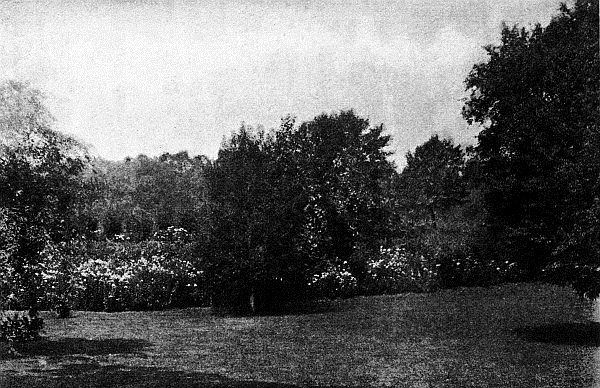
Planting on the edge of lawn
August second
The best and hardiest evergreen hedge is of Hemlock Spruce. Plants of this can be bought for fifteen dollars a hundred, and should be set eighteen inches apart.
The Privet is a favorite hedge in this country. It keeps green until December, and leafs out early in the spring. It is hardy and of rapid growth. Good plants are six dollars a hundred, and should be planted a foot apart. Catalogues say that if planted in rich soil one foot apart, a hedge five feet high can be grown in three seasons. Common Privet is more hardy than California Privet. Hydrangea paniculata grandiflora makes a beautiful low-growing hedge; good plants can be bought for six dollars a hundred. Berberis Thunbergii, or Barberry, makes a fine hedge, on account of its beautiful foliage and scarlet fruit. It is, however, slow-growing.
The owner of a small place should avoid the temptation to scatter flower beds about the lawn. Keep all the planting along the edges of the property and around the house, and leave the lawn unbroken by flower beds. The years when gardening consisted only of beds of Coleus, Geraniums, Verbenas and bedding plants have passed away, like the black walnut period of furniture. And even as the mahogany of our grandfathers is now brought forth from garrets and unused rooms, and antiquity shops and farm-houses are searched for the good old-time furniture, so we are learning to take the old gardens for our models, and the old-fashioned flowers to fill our borders.
The nurseryman of to-day has greatly improved the size and colour of the old varieties of perennials, so that they are far more beautiful than formerly, and offer a much greater choice. By skilful hybridization a hundred or more kinds of Phlox have been developed. In the same way, numerous varieties of Delphiniums, Iris, Peonies, Columbines, Canterbury Bells and Foxgloves have been produced. The old-fashioned annuals also appear in many new forms. In addition to the pink and white “Painted Lady,” the pure white and the dark purple Sweet Peas of our mothers’ time, we may now cultivate some eighty varieties of this delicate flower. Thus the garden of hardy perennials, annuals and bulbs will give us a continual sequence of flowers in every form and colour from April until November, if properly made and tended.

Asters in rows for picking
August twenty-fifth
THE SEED-BED
CHAPTER V
THE SEED-BEDThe possessor of a garden, large or small, should have a seed-bed, where seeds of perennials and some of the annuals can be sown and grown until large enough to be permanently placed. Not only will this bed give great pleasure in enabling one to watch the plants from the time the first tiny leaf appears, but also when laden with blossoms in fullest beauty. The knowledge that you have raised them gives a thrill of pride in the result which no bought plants, however beautiful, can impart. It is not necessary to prepare the seed-bed over a foot in depth, but the soil must be very light and fine, as well as rich. It is best, if possible, to have a portion of the bed somewhat shaded from the sun for a part of the day. If this combination cannot be had in one bed, there should be a second for plants that want less sun. Biennials must, of course, be sown every year, as they bloom but once, then die.
Every year some perennials will disappear, killed by severe winters, by pests of one kind or another, or dying without apparent cause. To keep up the supply, therefore, some of each variety should be raised every year.
Foxgloves and Sweet Williams, if allowed to go to seed, will sow themselves and increase rapidly. The same with Hollyhocks, but, except on the edges of shrubberies and in wild borders, it is better to cut the stalk just before the seed is ready to fall, and save it to sow in the seed-bed.
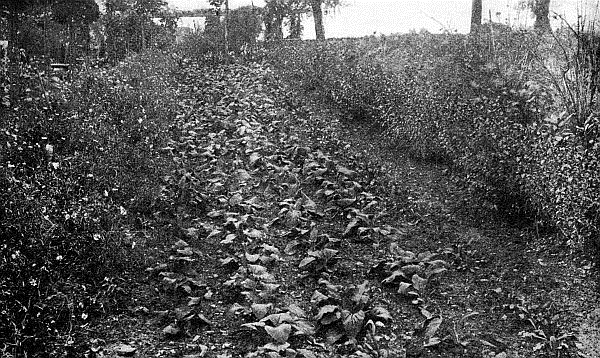
Foxgloves – seedlings ready for final transplanting
September twenty-ninth
In my garden, some seventy miles from New York, and where the spring opens ten days later, I sow my seeds, – the perennials about the tenth of April and the annuals from April twentieth to May first. Buy the seeds, if the garden is large, by the ounce or half-ounce; if small, in the seedsman’s packets. I always have the seeds of perennials soaked for twenty-four hours before planting, and find that by so doing they are very sure to germinate. Care must be taken, when soaking a number of different kinds at the same time, to place the name of each variety of seed under the glass or bowl containing the same. When ready for planting, pour off the water and mix the wet seeds carefully with very dry earth, in a cigar-box, which is of the right size and easy to handle. Then sow, not too deeply, in rows about a foot apart in the bed, covering very lightly, according to size. One-half inch is enough for the large seeds. The very fine varieties should simply have the earth sprinkled on them. If planted too deep they will never come up. Seeds of annuals do not require soaking.
Pat the earth down firmly with the back of the trowel, sprinkle with a fine sprinkler late every afternoon, and it is not your fault if you do not have hundreds and thousands of young plants to make your own place beautiful and to give to your friends. It is a keen delight, when a friend says that she has not raised such and such plants this year, to run and get your trowel and dig a bunch of this and that from the rows of sturdy little plants. It is a pleasure to know that a bit of your garden has gone to help make another’s beautiful.
One of the greatest pleasures of a garden is in giving flowers and plants to your friends. Every October, when arranging the borders and separating plants, I send away great boxes of them, some to fortunate friends with lovely gardens, but without the same varieties; some to humble cottage gardens, and others to friends who have never grown a flower, but would like to try. This year, having made a large new garden, I was able to give away to friends and neighbors only about seven hundred plants, not seedlings but large plants and roots. Generally I can send away far more. Think what a delight this is!
A request for some plants came to me last autumn from the baggage-master of a railroad station some twenty miles from us, who, by the boxes of shrubs and plants that came to me, inferred that I might have some to spare. I learned that all this man’s spare time was spent in his little garden plot, so great was his love of flowers. I know, too, a village expressman (another whom nature intended for a gardener), whose little plot of ground is always a mass of beauty. He has a surprising variety of plants, and every one is a fine specimen of its kind. His Anemone Japonica alba are the finest I have ever seen, each one sending up perhaps a dozen slender stalks of the beautiful flowers. I have had great difficulty with this plant and have lost dozens of them. I always drive very slowly by the expressman’s garden, burning with envy and wondering how he does it. In fact, it was only last year that I had my first success with these obdurate plants. They must grow under trees whose branches are sufficiently high to admit the sun half the day. As they bloom in September and October, the tree protects them from the frost, and in winter they should be well covered with stable litter. They are among the few plants to be set out in the spring, for if not well established they are always winter-killed.
It is well not to empty the perennial seed-bed entirely in the autumn, but to leave a few plants of each variety to transplant in the spring, to take the place of those which have not survived the winter. When the bed is empty, in the spring, have a good coating of manure spaded in and proceed again with the sowing.
Biennials, and also most perennials, must be raised every year to keep up the supply.
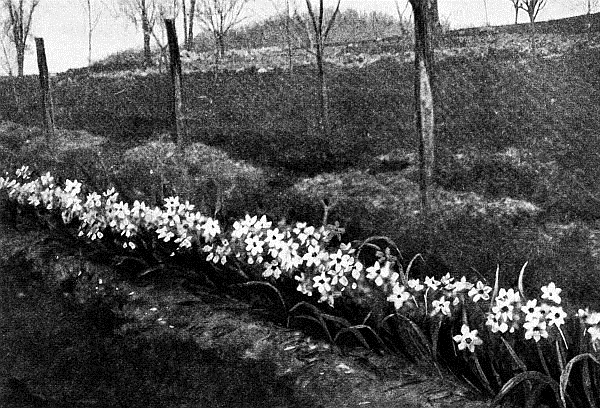
Long grass walk, with Narcissus Poeticus blooming in the border
April twenty-sixth
PLANTING
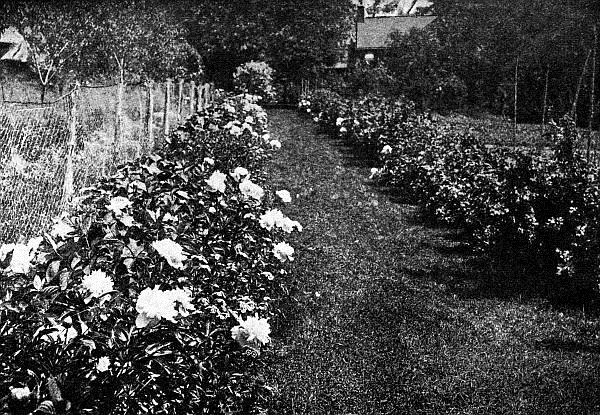
Long grass walk, with Peonies in the border
June sixth
CHAPTER VI
PLANTINGI cannot impress too strongly upon my readers the importance of ordering their plants and seeds of well-known firms. The best are always the cheapest in the end. Inquiry among friends will generally give the best information as to reliable seedsmen and growers. In ordering shrubs and plants it is important to specify the precise date of delivery, that you may know in advance the day of arrival. The beds or borders should be prepared in advance, so that everything may be set out without delay. Care must be taken that the roots are not exposed to the air and allowed to become dry. It is a good plan, when unpacking a box of plants, to sort them, laying each variety in a pile by itself, covering the roots with the moss and excelsior in which they were packed, and then, if at all dry, to sprinkle thoroughly. Unpacking should, if possible, be done under cover – in the cellar if there be no other place.
Great care must also be taken in setting out plants that ample room be given; as the roots should be well spread out and never doubled up. Do not be afraid of having the hole too big; see that the earth is finely pulverized and well packed about the roots; that the plant is thoroughly soaked, and, if the weather is dry, kept watered for a couple of weeks. If the plants have arrived in good condition and are carefully set out, but few should die. I have never lost a deciduous tree, and frequently, in setting out a hundred shrubs at one time, all have lived.
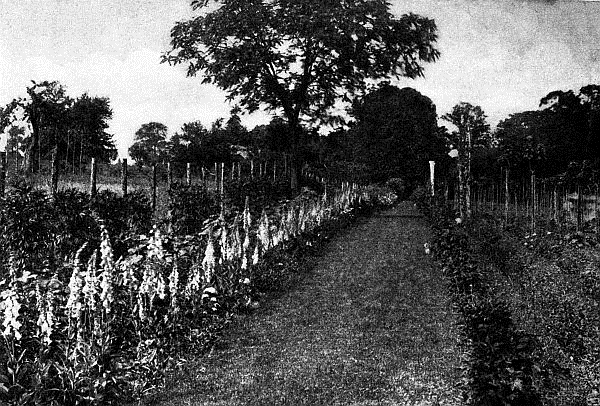
Long grass walk, with Foxgloves blossoming in the border

